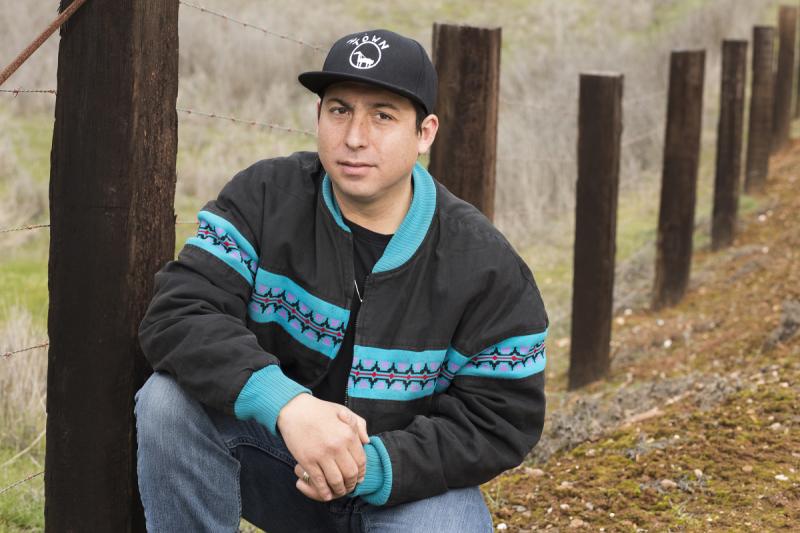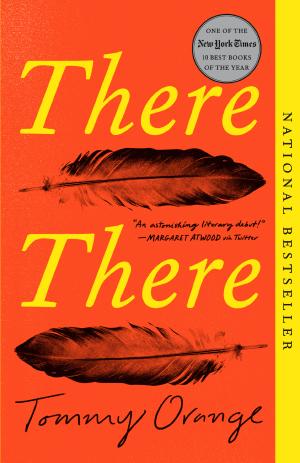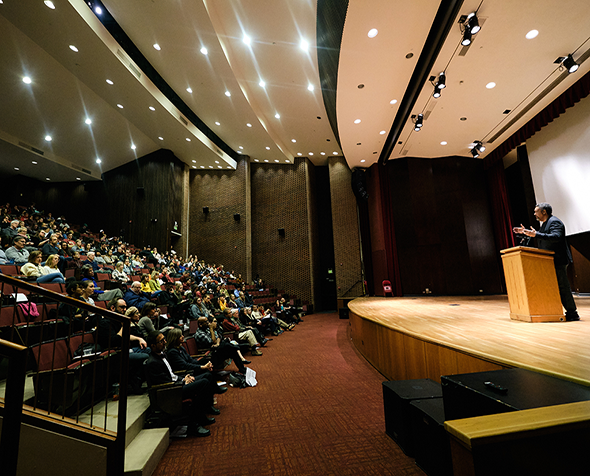Q&A: Tommy Orange, Author of "There There"

Photo by Elena Seibert
Bestselling and award-winning author Tommy Orange will be in conversation with Assistant Professor of Cultural Anthropology Kelly Fayard on Thursday, May 13 for the College of Arts, Humanities & Social Sciences' virtual Harper Distinguished Speaker Series lecture. RSVP here.
Interview courtesy of Penguin Random House.
Was there a particular event or idea that was the genesis for "There There"?
I was born and raised in Oakland, then worked off and on for eight years in the mental health department at the Native American Health Center in Oakland. I started working at the Health Center at the same time that I was falling in love with literature, with fiction, working at a used bookstore on the other side of town. I came to find there was very little in literature about Oakland, and almost nothing about Native people living in cities. In fact, the Native fiction I read made me feel less Native, or more alone, because it was about reservation life. Working in the Native community in Oakland, I found that the stories of the people I knew were not represented anywhere. But while the idea to represent my life and my community had been building in me over time, the idea for "There There" came to me in a single moment. I was driving down to L.A. with my wife. We’d just found out she was pregnant. And on that drive, on I-5 somewhere between Oakland and L.A., the idea for the novel was just suddenly there — as if knowing I’d be a father made the idea complete.
I’d known I wanted to write a novel with many voices and perspectives before the idea for the novel came to me. And I knew I wanted to write a novel about Oakland. A novel that feels like now. A fast-paced, unflinching polyphonic account from the invisible, the voiceless. "There There" is a novel about Oakland, California, and Indigenous people both born and raised in Oakland, as well as those who relocated from reservations. It’s about all of us trying to make sense of ourselves, our roots, in this day and age.
Can you tell us about the novel’s title?
The title comes from a Gertrude Stein quote. Regarding Oakland, Stein is quoted as having said, “There is no there there.” The way she meant it has to do with spending part of her childhood in a certain part of Oakland, then leaving and coming back years later to find it developed over, and unrecognizable. Why I chose it as a title for this novel has to do with the way Indigenous people everywhere experience themselves in this world. The world as it looked for Indigenous people pre-contact and pre-colonization is a different one — to say the least. We all have different ways to connect to the there once there for us, our families, what got passed down from our ancestors, our relatives, the land, both the benefits of culture and language as well as our legacies of pain, struggle and loss. One of our common stories as Indigenous people is our journey to making sense of the there there that is history, that place or position from which we attempt to derive truth and meaning. Some people talk about historical trauma. Others try to tell us to move on. But part of moving on is recognizing what came before. Taking responsibility for the ways we benefit from history or struggle because of it. We’re all trying to find ways back to what we come from, and to be who we are now all at once.
From the top of Canada to the bottom of South America, Indigenous people populated every inhabitable part of this land. That much is fact. How we carry on as Indigenous people now is difficult and complex and full of stories that haven’t been told yet.
Did you always know you would tell this story from the perspective of multiple characters? And how did you approach each character and the challenges of so many voices?
Before I knew what I wanted "There There" to be about, I knew I wanted it to be from an array of different voices. The first year of writing the book was just about attempting different voices, seeing what stuck to the page, which voices seemed like they could go longest and strongest. Some came early on, for instance Opal Viola Victoria Bear Shield, Dene Oxendene and Tony Loneman, others came late and fast, for instance I wrote the Thomas Frank chapter in 2016, and it came out in a ten-day flurry (or fury?) of sorts. The biggest challenge for me was doing the work to braid the characters’ lives in a convincing way that earns the title of novel, so that it wasn’t just a collection of linked stories trying to call itself a novel. Colum McCann’s structure of "Let the Great World Spin" was a big influence for me. Also Bolaño’s "Savage Detectives." I wanted the momentum to build and for all of the characters to come together at the end in a way that had a palpable arc, and in a way that seemed inevitable.
Why did you choose a powwow as the event at which all these lives intersect?
I’d found out about powwows in Oakland by working in the community. I worked on a powwow committee at one point. A shooting at a powwow seemed to me to represent something which had already happened to us, which could be seen on the page, in a novel, as happening now.
Powwows are intertribal. A whole bunch of different tribes coming together to celebrate in one single event, each bringing their own kinds of regalia and songs and dances. This is also the urban Indian experience. There are many people that come from many different tribes all trying to figure out what their identity means to them. Urban Indians also rarely have a chance to be together as a community, our lives don’t necessarily intersect, but powwows are one way we do that. It just made sense to me that this is where all these lives would intersect.
Your characters range widely in age and of course have lived through different times in history. Was there any historical research you did before writing?
I did a lot of research throughout; it’s an essential part of my process, whether it’s historical or about some random thought or word choice one of my characters makes. One of the biggest influences was time spent in the Oakland Native community over all the years I’ve lived and worked in Oakland. In coordination with the youth services department at the Native American Health Center, we took youth to Alcatraz and had elders — who’d been on the island at the time of the occupation — tell their stories. This was a powerful experience. But I wondered what the children on the island would have experienced. There were a lot of disillusioned families that came out of the civil rights movement then. Most of the chapter about Alcatraz is completely made up, but the power of witnessing young people hear stories of that time from people actually there was definitely a big influence on my thinking toward that particular chapter.
Is there a character in "There There" you feel a special affinity or connection to?
It would be impossible for me to pick. But they all have a lot of me in them. For those who know me and my life’s details really well, i.e. my wife, it isn’t hard to see me in all of them in a pretty big way. Thomas Frank is probably the character I feel most close to. My full first name is Thomas, and my middle name is Frank… but every character of course becomes their own over time, and moves further away from me. So Thomas Frank might be the closest, or maybe Dene Oxendene (the chapter where Dene is on a train going to meet a panel of judges about a storytelling grant, that all actually happened to me), and Opal Viola is maybe the furthest. But even with someone like Tony Loneman, and his meditations on what his face looks like, it doesn’t come from knowing anyone who’s been through that, or from research, it’s the way I’ve always felt about my own face. I know that might sound kinda sad or messed up, but it’s true.
In almost every chapter there is a moment where your character catches a glimpse of him or herself — in a mirror, a TV screen, a window, a piece of metal wall paneling. Coincident or not? If not, can you talk about this thread of literal self-reflection?
Being Native and Urban Indian is so much about disappearance. Not seeing ourselves in the world. There are almost no representations of us on screens that aren’t racist or historical or both. Seeing ourselves on screens is important, or in mirrors, trying to find who we are there, if we can’t find it anywhere else. The books opens with the representation of us on a screen — the Indian Head Test Pattern — and I wanted it to run as a theme throughout having to do with representation and self reflection in regard to identity.
Tommy Orange will be in conversation with Assistant Professor of Cultural Anthropology Kelly Fayard on Thursday, May 13. RSVP here.

 590x476.jpg)




